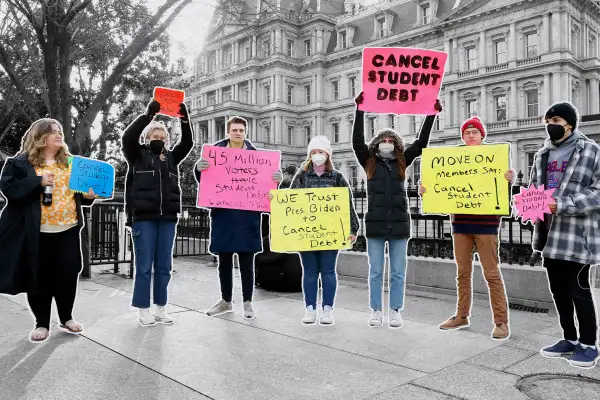Student Loan Forgiveness: New Research Shows Who Would Get the Largest Benefits

Wide-spread student loan forgiveness would predominantly benefit younger Americans living in high-income areas, according to a recent study by the Federal Reserve Bank of New York. But adding an income cap to any forgiveness policy would help to target a larger share of the benefits to borrowers in lower-income areas.
The Fed study comes two years into an interest-free forbearance period that the Education Department recently extended. Now, most federal student loan borrowers won't be required to make payments until September at the earliest.
Advocates of student loan forgiveness have taken the latest extension of the payment pause as a chance to double down on calls for sweeping loan cancellation, saying the Biden administration ought to wipe out millions in debt before turning payments back on.
President Biden, who’s said that he supports forgiving $10,000 of student debt through legislation, hasn’t come out in favor of using executive authority to cancel large amounts of debt. But his officials aren’t shutting down the notion entirely. Earlier this month, Jen Psaki, White House press secretary, said on an interview with the liberal podcast Pod Save America that using executive action to cancel some student loan debt was “still on the table.”
To measure who would benefit if forgiveness becomes a reality, the Fed authors looked at two popular proposals — canceling $10,000 and canceling $50,000. Under a policy of $50,000 worth of forgiveness, 29.9 million borrowers would see their full balance wiped out, and it would cost $904 billion. Meanwhile, forgiveness of $10,000 per borrower would cost $321 billion and eliminate the entire balance for 11.8 million borrowers, the study found.
Under either model, implementing an income cap of $75,000 would not only drop the cost of forgiveness by almost 45%, but it would also more directly target forgiveness to borrowers facing greater struggles with repayment.
This is not the first analysis of who would benefit most from student loan forgiveness. But the Fed says its new study is different because it fuses data from anonymized credit reports, which give more precise information about who has student loans and how much they owe.
How student loan forgiveness would affect people in different income levels
The Fed’s study found that under both forgiveness policies without income caps, borrowers residing in high-income neighborhoods would receive about 30% of debt forgiveness. Those in low-income areas would get about 25%. High-income neighborhoods were defined as those where the median annual income was $78,303 or higher, while low-income neighborhoods were those where the median annual income was below $46,310.
The Fed found that under the $50,000 forgiveness policy, the average federal student loan borrower living in a high-income neighborhood would receive $25,054 in loan forgiveness, while the average borrower living in a low-income neighborhood would get $22,512. This suggests that a bigger forgiveness amount would benefit higher earners.
Introducing an income eligibility cap of $75,000 — in other words, only granting loan forgiveness to borrowers who earned less than that — would shift the share of forgiven dollars away from higher-income neighborhoods. Under the model of $50,000 forgiveness with an income cap of $75,000, borrowers in high-income areas would receive about 18% of the benefit, down from around 30%. Borrowers in low-income neighborhoods would see their share of loan forgiveness jump from about 25% to 34%. The results are similar under the $10,000 forgiveness policy: an income cap would increase the share of benefits for people in low-income areas from about 25% to 35%.
Under each of the four policies examined, more than 60% of forgiven loan dollars would benefit borrowers under the age of 40. Those 60 and older would receive about 6% of forgiven dollars in each of the four proposals.
Most student loan borrowers (67%) are under 40. But younger borrowers also tend to have smaller balances, likely because larger balances come from borrowing for graduate school and graduate school attendees are older, on average.
Borrowers with lower credit scores would benefit most from forgiveness
As a group, student loan borrowers tend to have lower credit scores than the population at large. According to the Fed’s study, about 34% of all credit scores are greater than 760, which it considers super prime. However, only 11% of student loan borrowers have credit scores above 760. Credit score vary across generations, with older Americans having higher scores overall. This may explain why borrowers, who tend to be younger, have lower credit scores than the wider population.
As a result, forgiveness tends to help people with comparatively low credit score. Under all four proposals, more than half of forgiven debt would go to borrowers with credit scores under 660. That means most of the debt forgiven would go to borrowers with below-average credit scores. (The national average credit score is 690, according to the credit reporting bureau Equifax.)
Restricting forgiveness based on a borrower's income would further benefit those with the lowest credit scores: Under both amounts of loan forgiveness with a $75,000 income cap, the share of benefits that go to borrowers with credit scores below 620 is about 42%. Without the income cap, those borrowers receive only about 37% of dollars forgiven.
More from Money
Here's How Much Student Loan Borrowers Will Owe When Payments Restart

